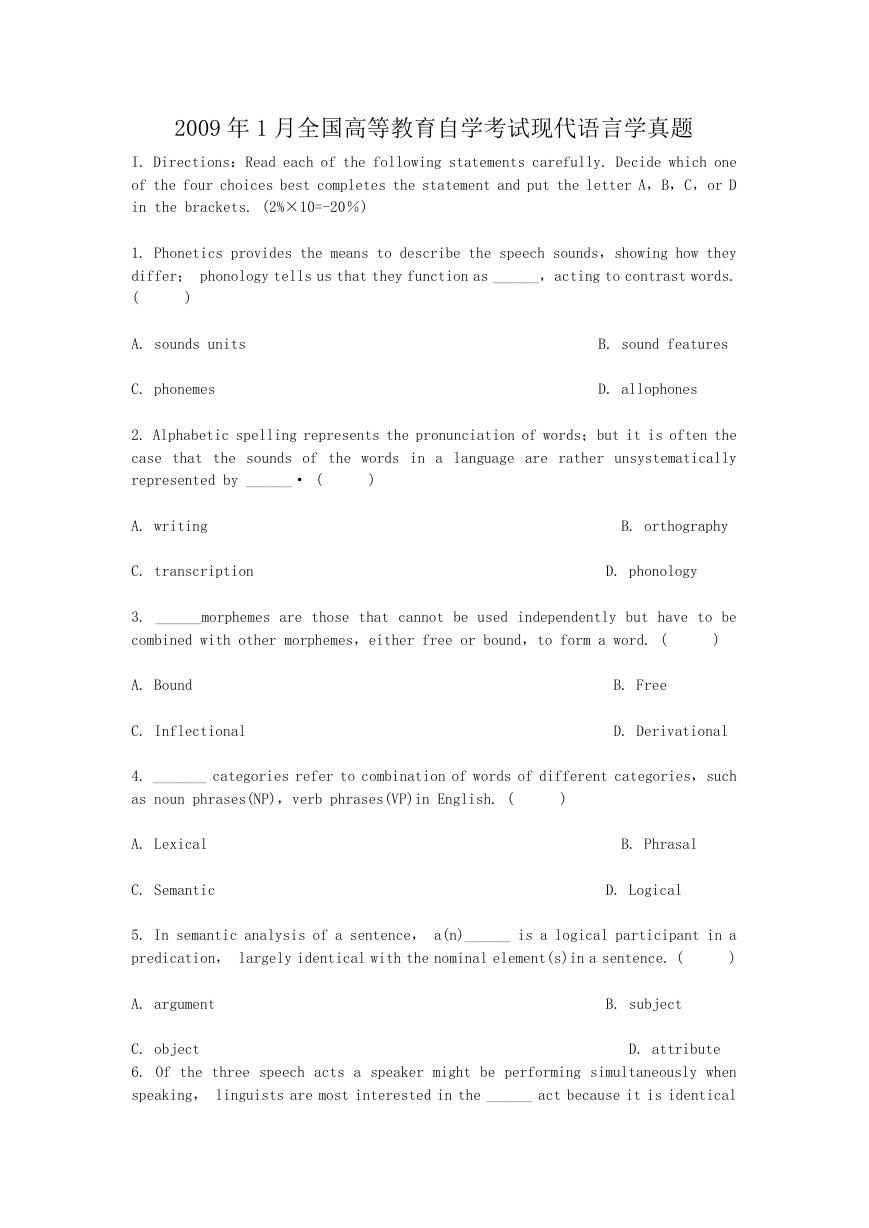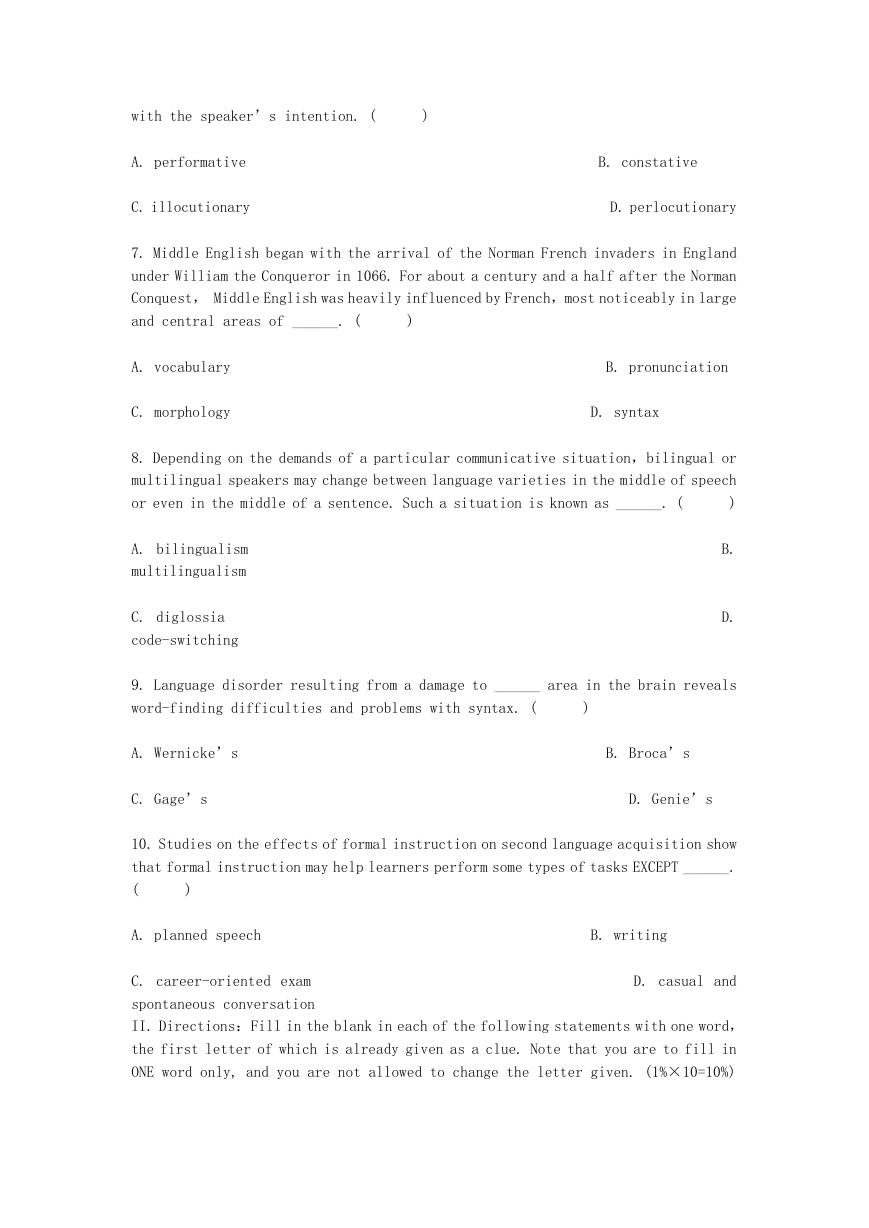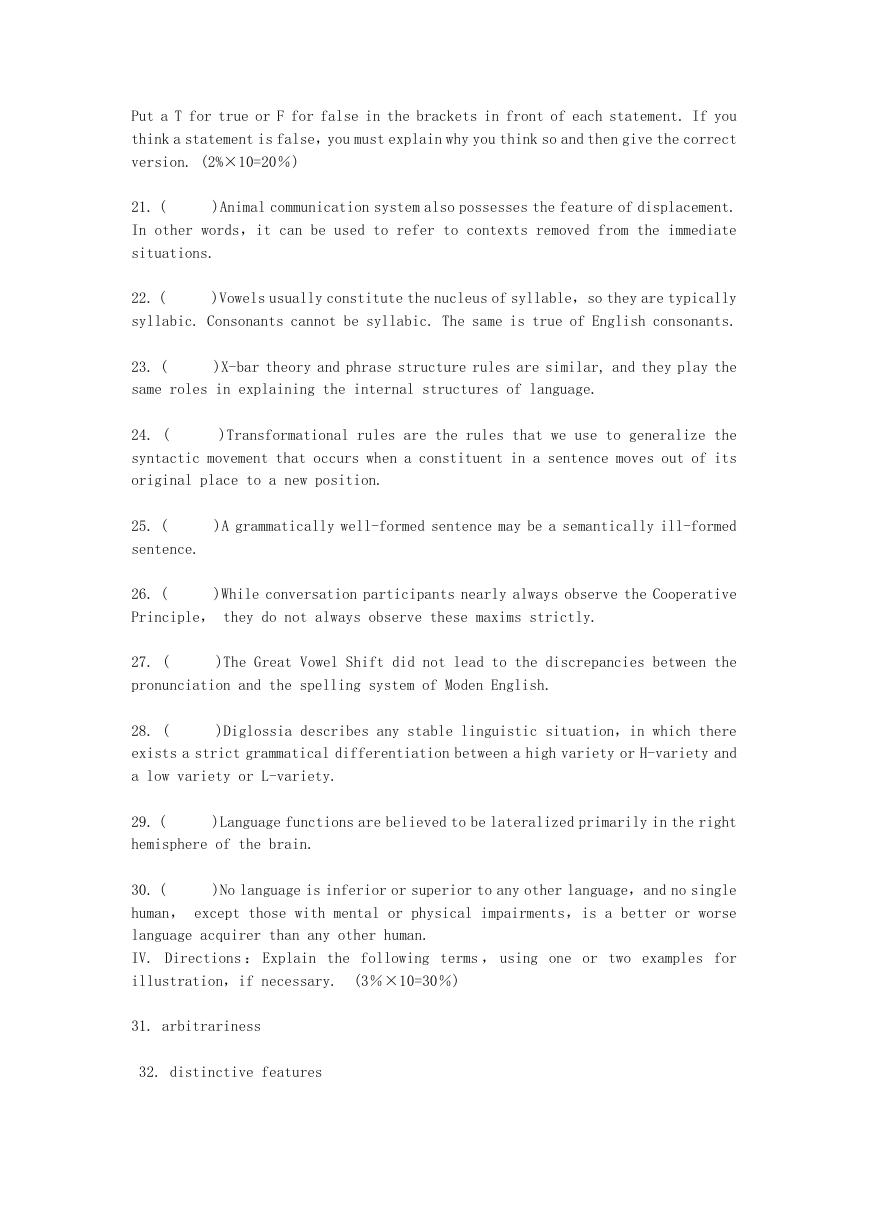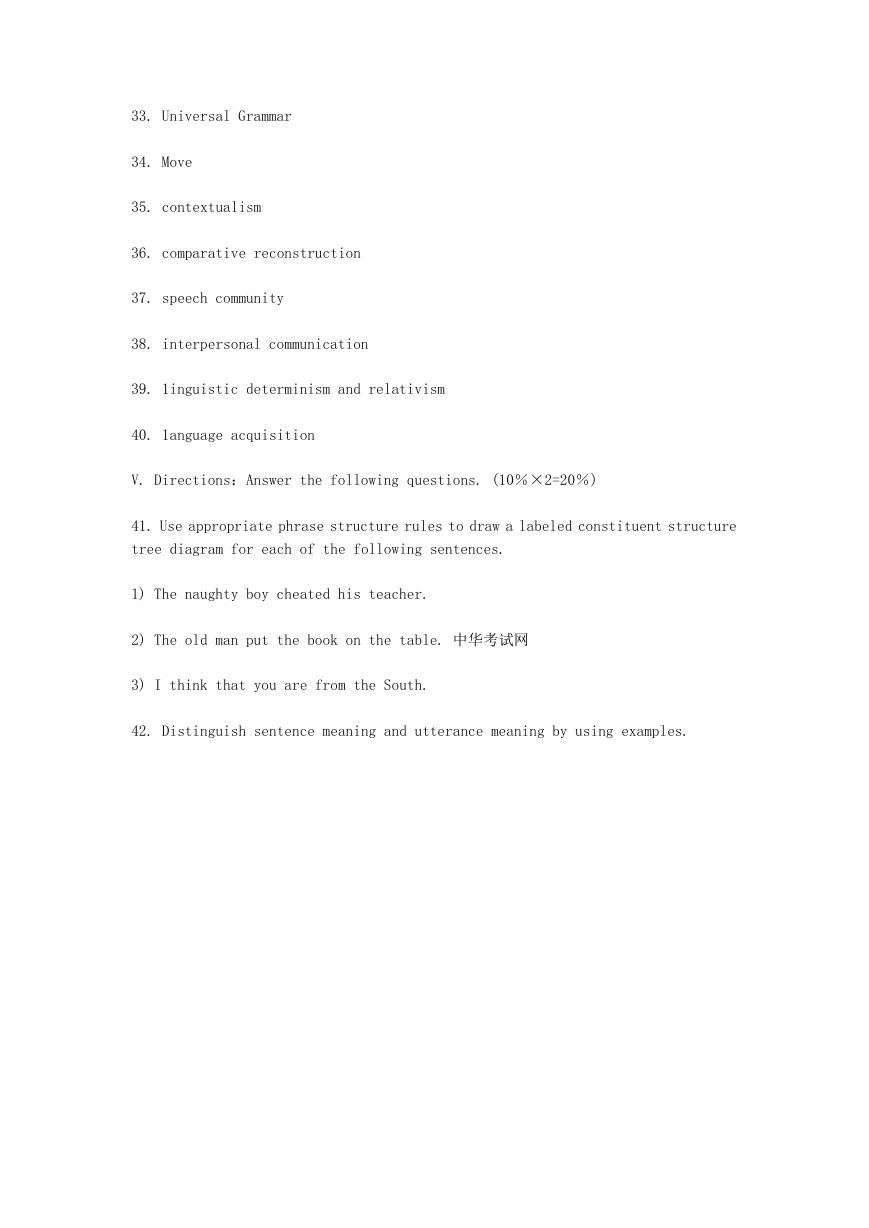2009 年 1 月全国高等教育自学考试现代语言学真题
I. Directions:Read each of the following statements carefully. Decide which one
of the four choices best completes the statement and put the letter A,B,C,or D
in the brackets. (2%×10=-20%)
1. Phonetics provides the means to describe the speech sounds,showing how they
differ; phonology tells us that they function as ______,acting to contrast words.
(
)
A. sounds units
C. phonemes
B. sound features
D. allophones
2. Alphabetic spelling represents the pronunciation of words;but it is often the
case that the sounds of the words in a language are rather unsystematically
represented by ______· (
)
A. writing
C. transcription
B. orthography
D. phonology
3. ______morphemes are those that cannot be used independently but have to be
combined with other morphemes,either free or bound,to form a word. (
)
A. Bound
C. Inflectional
B. Free
D. Derivational
4. _______ categories refer to combination of words of different categories,such
as noun phrases(NP),verb phrases(VP)in English. (
)
A. Lexical
C. Semantic
B. Phrasal
D. Logical
5. In semantic analysis of a sentence, a(n)______ is a logical participant in a
predication, largely identical with the nominal element(s)in a sentence. (
)
A. argument
B. subject
C. object
6. Of the three speech acts a speaker might be performing simultaneously when
speaking, linguists are most interested in the ______ act because it is identical
D. attribute
�
with the speaker’s intention. (
)
A. performative
C. illocutionary
B. constative
D. perlocutionary
7. Middle English began with the arrival of the Norman French invaders in England
under William the Conqueror in 1066. For about a century and a half after the Norman
Conquest, Middle English was heavily influenced by French,most noticeably in large
and central areas of ______. (
)
A. vocabulary
C. morphology
B. pronunciation
D. syntax
8. Depending on the demands of a particular communicative situation,bilingual or
multilingual speakers may change between language varieties in the middle of speech
)
or even in the middle of a sentence. Such a situation is known as ______. (
A. bilingualism
multilingualism
C. diglossia
code-switching
B.
D.
9. Language disorder resulting from a damage to ______ area in the brain reveals
word-finding difficulties and problems with syntax. (
)
A. Wernicke’s
C. Gage’s
B. Broca’s
D. Genie’s
10. Studies on the effects of formal instruction on second language acquisition show
that formal instruction may help learners perform some types of tasks EXCEPT ______.
(
)
A. planned speech
B. writing
C. career-oriented exam
spontaneous conversation
II. Directions:Fill in the blank in each of the following statements with one word,
the first letter of which is already given as a clue. Note that you are to fill in
ONE word only, and you are not allowed to change the letter given. (1%×10=10%)
D. casual and
�
linguistics,unlike the linguistic study normally known as “grammar”
l1. M
which sets models and rules for language users to follow,is mostly descriptive,
i.e.,it attempts to describe the language people actually use,be it “correct”
or not.
12. Many languages,including English,have vowels called d
be described as a sequence of two vowels.
,which could also
r
13. A
is often seen as part of a word;it can never stand by itself although
it bears clear, definite meaning;it must be combined with another similar form or
an affix to form a word.
14. In a complex sentence,the incorporated,or subordinate,clause is normally called
an
e
clause.
15. In the English vocabulary there are two categories of words:n
borrowed words.
words and
16. “Your money or your life!” aims to threaten,and it is a specific instance
of d
·
17. Back formation refers to a process by which new words are coined from already
existing words by taking away an a
thought to be part of the old word,for
example,edit derived from editor on the mistaken assumption that “-or” was the
agentive suffix.
18. In the 1969 edition of the American Heritage Dictionary,examples used to
illustrate the meaning of words include “manly courage’’ and “masculine charm. ’’
Women do not fare as well. as exemplified by “womanish tears’’ and “feminine
wiles.’’ This indicates that language reflects
s
in society.
period hypothesis refers to a period in one’s life extending from
19. The c
about age two to puberty, during which the human brain is most ready to acquire a
particular language.
20. Although they lack grammatical morphemes,t
sentences in the multiword
stage are not simply words randomly strung together, but follow the principles of
sentence formation.
III. Directions:Judge whether each of the following statements is true or false.
�
Put a T for true or F for false in the brackets in front of each statement. If you
think a statement is false,you must explain why you think so and then give the correct
version. (2%×10=20%)
21. (
)Animal communication system also possesses the feature of displacement.
In other words,it can be used to refer to contexts removed from the immediate
situations.
22. (
)Vowels usually constitute the nucleus of syllable,so they are typically
syllabic. Consonants cannot be syllabic. The same is true of English consonants.
23. (
same roles in explaining the internal structures of language.
)X-bar theory and phrase structure rules are similar, and they play the
24. (
)Transformational rules are the rules that we use to generalize the
syntactic movement that occurs when a constituent in a sentence moves out of its
original place to a new position.
25. (
sentence.
)A grammatically well-formed sentence may be a semantically ill-formed
26. (
Principle, they do not always observe these maxims strictly.
)While conversation participants nearly always observe the Cooperative
27. (
pronunciation and the spelling system of Moden English.
)The Great Vowel Shift did not lead to the discrepancies between the
28. (
)Diglossia describes any stable linguistic situation,in which there
exists a strict grammatical differentiation between a high variety or H-variety and
a low variety or L-variety.
29. (
hemisphere of the brain.
)Language functions are believed to be lateralized primarily in the right
30. (
)No language is inferior or superior to any other language,and no single
human, except those with mental or physical impairments,is a better or worse
language acquirer than any other human.
IV. Directions : Explain the following terms , using one or two examples for
illustration,if necessary.
(3%×10=30%)
31. arbitrariness
32. distinctive features
�
33. Universal Grammar
34. Move
35. contextualism
36. comparative reconstruction
37. speech community
38. interpersonal communication
39. 1inguistic determinism and relativism
40. 1anguage acquisition
V. Directions:Answer the following questions. (10%×2=20%)
41. Use appropriate phrase structure rules to draw a labeled constituent structure
tree diagram for each of the following sentences.
1) The naughty boy cheated his teacher.
2) The old man put the book on the table. 中华考试网
3) I think that you are from the South.
42. Distinguish sentence meaning and utterance meaning by using examples.
�










 2023年江西萍乡中考道德与法治真题及答案.doc
2023年江西萍乡中考道德与法治真题及答案.doc 2012年重庆南川中考生物真题及答案.doc
2012年重庆南川中考生物真题及答案.doc 2013年江西师范大学地理学综合及文艺理论基础考研真题.doc
2013年江西师范大学地理学综合及文艺理论基础考研真题.doc 2020年四川甘孜小升初语文真题及答案I卷.doc
2020年四川甘孜小升初语文真题及答案I卷.doc 2020年注册岩土工程师专业基础考试真题及答案.doc
2020年注册岩土工程师专业基础考试真题及答案.doc 2023-2024学年福建省厦门市九年级上学期数学月考试题及答案.doc
2023-2024学年福建省厦门市九年级上学期数学月考试题及答案.doc 2021-2022学年辽宁省沈阳市大东区九年级上学期语文期末试题及答案.doc
2021-2022学年辽宁省沈阳市大东区九年级上学期语文期末试题及答案.doc 2022-2023学年北京东城区初三第一学期物理期末试卷及答案.doc
2022-2023学年北京东城区初三第一学期物理期末试卷及答案.doc 2018上半年江西教师资格初中地理学科知识与教学能力真题及答案.doc
2018上半年江西教师资格初中地理学科知识与教学能力真题及答案.doc 2012年河北国家公务员申论考试真题及答案-省级.doc
2012年河北国家公务员申论考试真题及答案-省级.doc 2020-2021学年江苏省扬州市江都区邵樊片九年级上学期数学第一次质量检测试题及答案.doc
2020-2021学年江苏省扬州市江都区邵樊片九年级上学期数学第一次质量检测试题及答案.doc 2022下半年黑龙江教师资格证中学综合素质真题及答案.doc
2022下半年黑龙江教师资格证中学综合素质真题及答案.doc